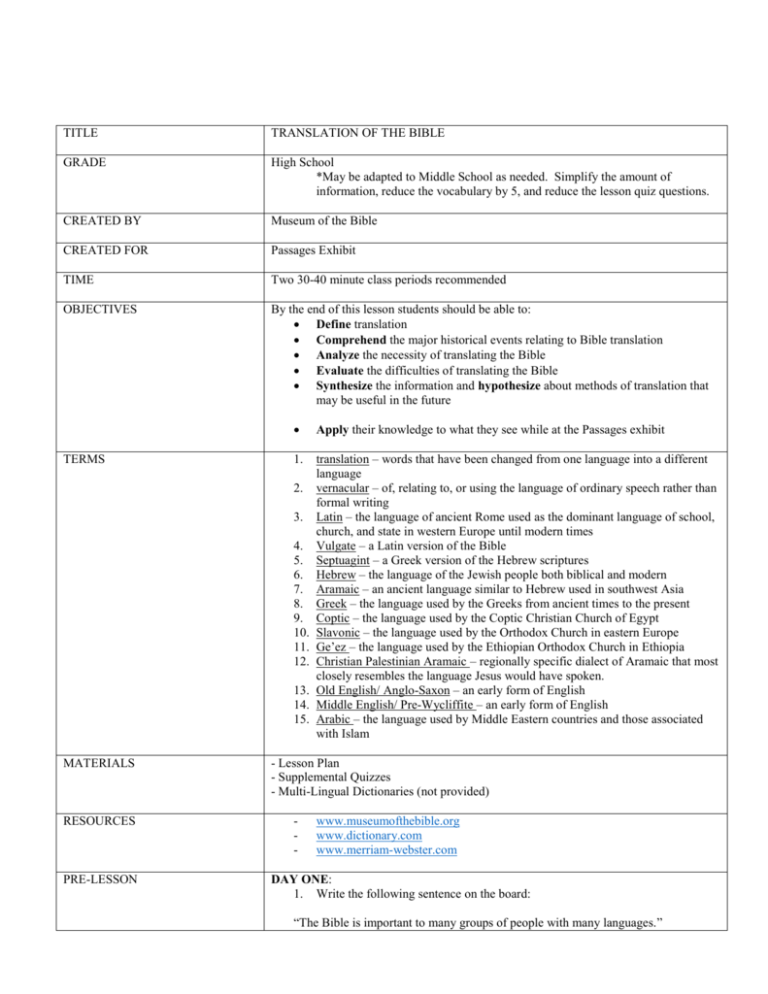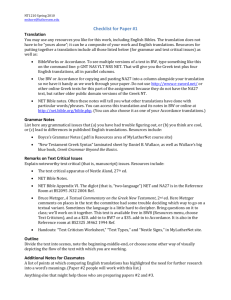Lesson Plan
advertisement

TITLE TRANSLATION OF THE BIBLE GRADE High School *May be adapted to Middle School as needed. Simplify the amount of information, reduce the vocabulary by 5, and reduce the lesson quiz questions. CREATED BY Museum of the Bible CREATED FOR Passages Exhibit TIME Two 30-40 minute class periods recommended OBJECTIVES By the end of this lesson students should be able to: Define translation Comprehend the major historical events relating to Bible translation Analyze the necessity of translating the Bible Evaluate the difficulties of translating the Bible Synthesize the information and hypothesize about methods of translation that may be useful in the future TERMS Apply their knowledge to what they see while at the Passages exhibit 1. translation – words that have been changed from one language into a different language vernacular – of, relating to, or using the language of ordinary speech rather than formal writing Latin – the language of ancient Rome used as the dominant language of school, church, and state in western Europe until modern times Vulgate – a Latin version of the Bible Septuagint – a Greek version of the Hebrew scriptures Hebrew – the language of the Jewish people both biblical and modern Aramaic – an ancient language similar to Hebrew used in southwest Asia Greek – the language used by the Greeks from ancient times to the present Coptic – the language used by the Coptic Christian Church of Egypt Slavonic – the language used by the Orthodox Church in eastern Europe Ge’ez – the language used by the Ethiopian Orthodox Church in Ethiopia Christian Palestinian Aramaic – regionally specific dialect of Aramaic that most closely resembles the language Jesus would have spoken. Old English/ Anglo-Saxon – an early form of English Middle English/ Pre-Wycliffite – an early form of English Arabic – the language used by Middle Eastern countries and those associated with Islam 2. 3. 4. 5. 6. 7. 8. 9. 10. 11. 12. 13. 14. 15. MATERIALS RESOURCES PRE-LESSON - Lesson Plan - Supplemental Quizzes - Multi-Lingual Dictionaries (not provided) - www.museumofthebible.org www.dictionary.com www.merriam-webster.com DAY ONE: 1. Write the following sentence on the board: “The Bible is important to many groups of people with many languages.” 2. 3. Give students various multi-lingual dictionaries (Spanish-English, GermanEnglish, French-English). They don’t have to be the same. Have the students attempt to translate the sentence into the other language. DAY TWO: Review concepts from previous day. MOTIVATION Discuss the difficulty of the pre-lesson task. 1. What made this difficult? 2. Were you able to finish? 3. What would have been helpful for you to finish faster? 4. Did any of the words not have a direct word for word translation? 5. Did any of the words mean something different in the other language? 6. Did the word order change? PROCEDURES After discussing the translation activity, the class then proceeds to discuss the things they will see in the exhibit – in this lesson specifically, the translation of the Bible. 1. Discuss some difficulties that could occur with translating the Bible. a. To those who believe the text, there are serious moral implications if the text is translated incorrectly. b. The person interpreting may have to choose “the best” word to translate if there is no direct correlation, therefore his/ her bias may direct the interpretation of the text. 2. Discuss and define translation on the board. (see definition) 3. Specify that definition to the Bible. Now that the background for the concept of translation has been established, move on to what is specifically at Passages. Keep moving the conversation back to the original big picture idea – that translating the Bible is necessary, but very difficult. Discuss the questions in blue with the students in class to add to the lesson and preparation for the later quiz. In Passages: 1. Early Vernacular Translations a. The first major translation of the biblical text was the Old Testament from Hebrew to Greek. This was called the Septuagint. b. Jerome was asked, in the 5th century, to create a Latin version of the Bible that could be used in the churches. There were many piece-meal Latin translations out there, but this one was meant to replace all of those. c. Jerome stated in one of his letters that he translated “not word for word, but sense for sense,” meaning he had to translate the context and meaning of the idea being expressed, not just the words. d. Other early translations of the Old and New Testament were made in Coptic, Christian Palestinian Aramaic, and Ge’ez (the language of Ethiopia). What are some ways a translator’s personal beliefs and experiences could alter the resulting translation? o Possible Answer: One word in Hebrew could have two English words that mean slightly different things. The translator has to choose which one based on their best interpretation. Is any translation free from interpretation? Why? o Answer: No, because every translator makes decisions on every word choice. 2. European Translations a. Europeans primarily used the Latin Vulgate for church liturgy for 3. 4. 5. centuries. There were, however, other translations becoming available. Dutch, French, and especially the German translations were beginning to circulate. b. The English took a little longer. Early versions in English show up as Anglo-Saxon and Middle English. What are some possible reasons why it took the English so much longer to get their own Bible translation? o Possible Answers: As a country, England was far more isolated that the rest of the European continent. Also, the government was unstable for much of the time, with tense relationships between the monarchy and the church. Non-European Translations a. Middle Eastern countries were producing vernacular translations earlier than many European countries. b. These translations include Hebrew, Samaritan, Aramaic, Syriac, Arabic, and Armenian. Why do you think Middle Eastern countries had more vernacular translations than the European countries? o Possible Answers: The countries are geographically closer to the location of Bible’s events so the information didn’t have to travel as far. Plus, these countries were not a part of the Roman Catholic Church which used primarily the Latin Vulgate for all church-related things. The English Bible - William Tyndale and King Henry VIII of England a. William Tyndale was translating and printing English versions of the Bible in the 16th century, when it was illegal in England to do so. b. He was exiled, so he began smuggling small English New Testaments back into England in grain sacks. c. He was eventually imprisoned and sentenced to death for heresy. While in prison he continued to translate the Old Testament, having already finished translating the New Testament. d. He was strangled to death, then burned at the stake, in 1536. He did not complete a full translation of the whole Bible, but what he did finish is considered one of the best English translations of all time. Over 80% of it was used in the later King James Version. What is a possible reason why it would have been illegal to translate the Bible into English? o Possible Answer: The Roman Catholic Church was mainly concerned with the quality of what translation was put out to the people. Imagine if just anyone decided they wanted to translate the Bible, knowing how much personal interpretation goes into it. There could be some very bad and misleading information circulating among the people. The English Reformation – Reformation Translations a. After Tyndale’s death his apprentice, John Rogers, finished his translation and printed what’s known as the Matthew’s Bible. b. The king authorized an English translation of the Bible three years after Tyndale’s death, during the time of the English Reformation, when Henry VIII split from the Roman Catholic Church. c. The translations that followed are: the Great Bible (Church of England), the Geneva Bible (Puritan), the Bishops’ Bible (Church of England), and the Rheims New Testament (Catholic), among others. 6. 7. Considering all the different versions of English translations that followed the king’s authorization, do you agree or disagree with the Roman Catholic Church’s idea that one standard translation is better? o Possible Answers: Some may say yes, they agree, because with a standard version everyone is learning the same thing. Some may say no, because people should be free to make up their own minds. Translating into an English Bestseller - The King James Bible a. In the early 17th century, King James I decided to create his own English translation that would replace all of the other ones. b. He called a committee of 47 men from different backgrounds together and they spent 7 years creating what is known as the King James Version of the Bible in 1611. c. It is considered to be one of the greatest works of English literature for its choice language and flowing prose. d. It was and is the best-selling version of the Bible. Name some common English phrases that came from the King James Version. o Possible Answers: An eye for an eye, my brother’s keeper, love thy neighbor, drop in the bucket, blind leading the blind, etc. (google “common phrases in the King James Version” for more) Modern Translations a. There are now more translations of the Bible than in any other time period in history. b. Mission organizations and Bible societies strive toward the goal of having a Bible translation in every language in the world. We know translation is not an exact system. Not every word has a direct correlation. What do you do when the group of people you are communicating with have no sense of the concept behind certain words? (For example: atonement, salvation, the holy trinity, sacrament, messiah, heaven, hell, etc.) o Possible Answers: Can vary. Try to generate a discussion about this topic and get some real solutions from students. POST-LESSON Concluding Questions: 1. Was Bible translation necessary? Is it necessary now? a. Answers can vary. 2. How could translating the Bible from the original languages cause problems? a. Possible Answer: There is often not a word for word correlation, therefore the translator must also be the interpreter. 3. What do you do for those who don’t read, or don’t even have a written language? a. Possible Answer: Videos and storytelling person to person. In history, missionaries have created a written language for the people, then translated the Bible into that (look up John Eliot and the Natick Indians). Some missionaries taught the people English, then gave them an English version. ASSESSMENT Your choice. Options are: (see supplemental material) - Vocabulary Quiz o Answers: c, b, j, g, l, e/o, f, I, m, n, k, d, a, h, e/o - Lesson Quiz (Questions are those highlighted in blue on lesson plan) Exhibit Quiz (for use when visiting the exhibit) *Further research topics could be assigned based upon any of the aforementioned material.







